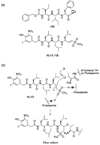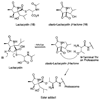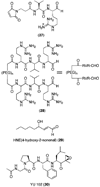The ubiquitin-proteasome pathway and proteasome inhibitors
- PMID: 11410931
- PMCID: PMC2556558
- DOI: 10.1002/med.1009
The ubiquitin-proteasome pathway and proteasome inhibitors
Abstract
The ubiquitin-proteasome pathway has emerged as a central player in the regulation of several diverse cellular processes. Here, we describe the important components of this complex biochemical machinery as well as several important cellular substrates targeted by this pathway and examples of human diseases resulting from defects in various components of the ubiquitin-proteasome pathway. In addition, this review covers the chemistry of synthetic and natural proteasome inhibitors, emphasizing their mode of actions toward the 20S proteasome. Given the importance of proteasome-mediated protein degradation in various intracellular processes, inhibitors of this pathway will continue to serve as both molecular probes of major cellular networks as well as potential therapeutic agents for various human diseases.
Copyright 2001 John Wiley & Sons, Inc.
Figures











References
Publication types
MeSH terms
Substances
Grants and funding
LinkOut - more resources
Full Text Sources
Other Literature Sources

